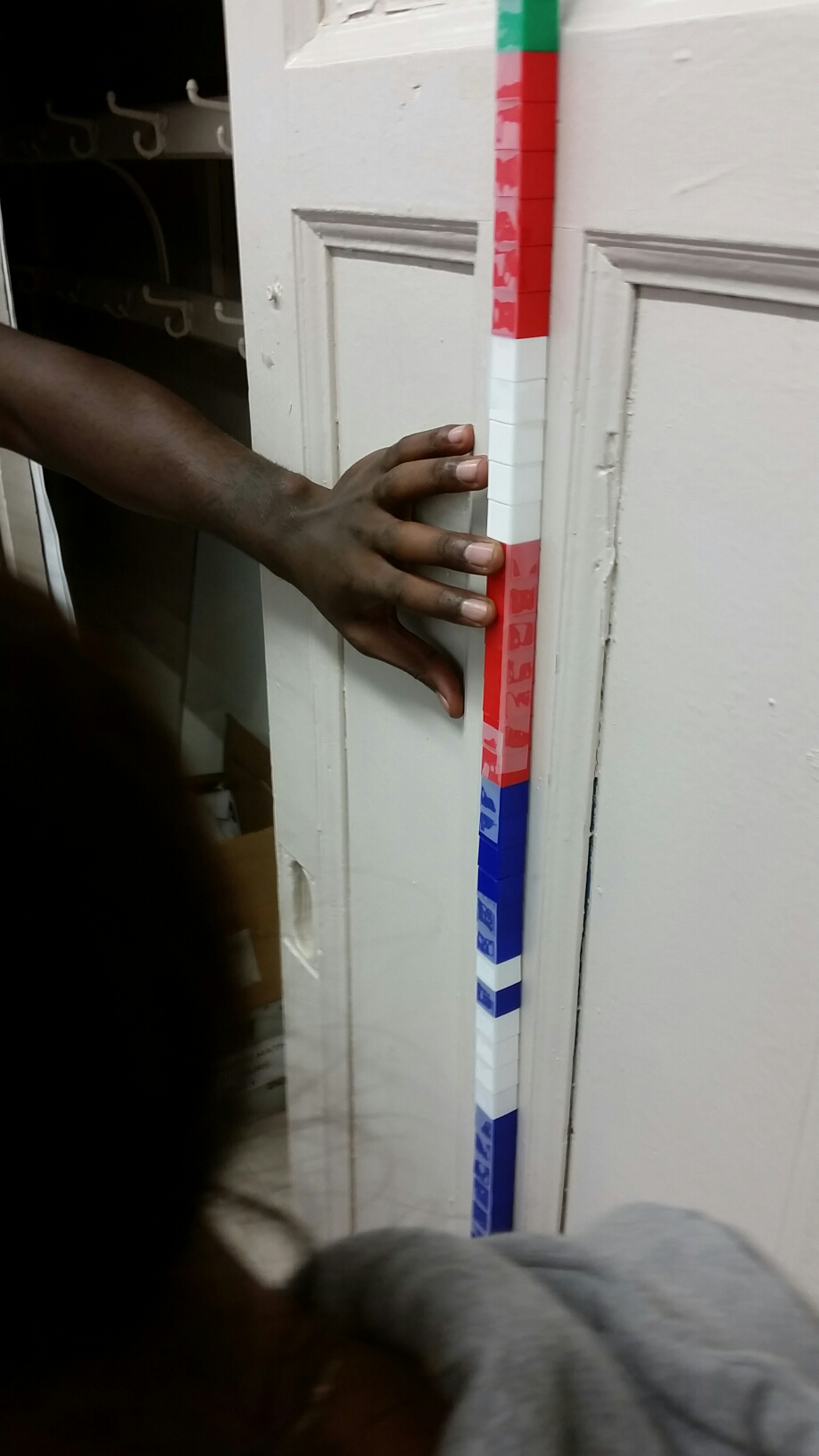Here are the slides for my presentation. Thank you for all you people who waited until the last session and ignored a transit strike to come to my talk!
Page 17 of 40
I’ve been thinking about a moment from 13 years ago while I was observing Kellie Huhn teach sophomores during my time MSU. 13 years have made the details of the lesson very fuzzy (F.O.I.L.? Standard Form? Quadratics?). What comes back to me was a quick explanation she made about the decision to go “off book” for a lesson. She could have said this: “These kids are getting a little antsy because we are going through all this content so I’m going to have to give them something in context.” It was clear that the class wasn’t behaving poorly, and were ‘doing the work’, but everything seemed deflated. Kellie picked up on this and was using her pedagogic license to direct the class through an activity that would recapture the kids minds. Again, I’m fuzzy on the details on what that actually was (Card sort? Skits? Rich problem set?), but the though still stays with me. As a teacher whose teaching was so non-traditional, I’m pretty sure that my 3 or 4 months of observations taught me that teaching doesn’t have to mean following the book, and challenged me to be inventive as I serve my future students.
So this long weekend I was thinkingabout adding energy to my current class when Kellie’s comment about content and context came to mind. Instructional routines and tasks can seem pretty dry for kids. Without balance it feels a lot more like mastering content than it does real-world context for students. While we spent the last week of class tying together the various representations of linear functions, we may have forgot why they make our lives easier. It seemed time to take Kellie’s words to heart. In thinking of that I decided to adjust the unit a little. I took a modeling activity from 2 weeks from now and decided to run a simpler version of it today.
The actual task that I got was from Dan Meyer’s blog which asked “How many Styrofoam cups unifix cubes would you need to be as tall as your teacher?” Kids could work together and think through the problem, take measurements, and make a prediction. Since I have a crapload of unifix cubes, they could then actually physically put together the 103 (give or take) cubes to reach my height. In the end it ended up being less of a linear modelling activity and more of a estimation activity, but I think it was something that spoke to the point of precision, counting, answering genuine problems, teamwork, and what math class is all about.
(Side note: Before class started one girl who pulled me aside and asked if I thought she should transfer out of the class because it was too hard. At the end of this, her group ended up getting the closest estimate, and it was largely because of her!)
Unfortunately, this means that we aren’t where I wanted to be in the unit. The kids had a lot of fun and were able to apply a lot of the linear thinking that we have been doing to a real context. We’ll just have to derive the slope formula next class while we wrap up linear thinking with an end of the unit reflection.
Today’s class began with a plan to break up the monotony, and I left feeling the need to take even more drastic action for the monotony. The day before I was talking with a special ed teacher who was the advisor of one of my students. “He needs thing to be EXCITING.” she said “He’s a skateboarder. If he’s not in your class it’s because he’s out around the building skateboarding. Your classes have to compete with skateboarding.” I immediately thought of this as a challenge. How do you make math class as interesting as skateboarding?
Initially I thought about the process skateboarders take to get better. Skateboarding offers lots of real-time feedback to help you learn how to master a new trick. Math offers similar real-time feedback if the students learn to check their own work and are given opportunities to be independent. With confidence and effort they can follow the sort of instantaneous feedback of their own thinking while working towards solving a problem. In a lot of ways the work one does to master a skateboard trick is similar to the work one does to learn math.
So I was about 3/4 through that explanation when my co-worker stopped me and said “Also, you could have the kids moving around and doing cool stuff.” To which I replied “Well… yeah… Of course that too.”
It was one of the few times a conversation in teaching has left me both dumbfounded and also spinning with ideas. Large scale experiments and physical explorations is something I haven’t done in my class, but is something that has been done in her class (her students build and fly a hot air balloons…on the first or second day of class). It made me think about doing more modeling and less pen and paper work. Maybe the spaghetti bridge to talk about linear modelling, maybe a catapult to talk about quadratic modelling, maybe something with building skateboard ramps? Who knows, ANYTHING IS POSSIBLE!!!
Naturally, the lesson I had planned felt as exciting as a bowl of bran flakes in comparison. OK not entirely, we did the connecting representations activity that I remember from TMC-NYC. Some notes for people doing that. It’s good to have the representations on chart paper so you can have the prompts on the screen. I intended to have the images at the bottom of this google doc as the representations to connect. I noticed that the sort of silence and the lack of writing really helped some kids make connections. One pair of students only on their second day in the class began the activity saying “I don’t get this” but were able to create their own.
The rest of the class was spent working on some activities that I used to think were the Cat’s pajamas but now they just seem boring. At least that’s how the kids experienced it. Maybe the conversation made me less exciting to teach this stuff, or maybe it’s time for something new. Either way I have four days of weekend to think of something more exciting and I hope to spend at least one day doing just that.
It was a rough day at the office for the past few days.
Friday was a terrible example of something I’ll call idea creep. We were  reviewing the Do Now, a visual pattern, and a students said something about area when describing a growing square. One student said it grew wider and longer. I suggested the word ‘geometrically’ and I said that was interesting. Then I kept talking…
reviewing the Do Now, a visual pattern, and a students said something about area when describing a growing square. One student said it grew wider and longer. I suggested the word ‘geometrically’ and I said that was interesting. Then I kept talking…
Flash back to before the class and I remember having a whole bit about arithmetic and geometric sequences because it might be interesting. There really wasn’t time to do it, but the idea of talking about sequences alongside these visual patterns still lingered.
After the student noticed decided to interject a little of the sequence language, so I mentioned ‘geometrically’ The class wasn’t as excited as I had expected. Next thing you know I am pointing to another pattern that wasn’t a geometric sequence so they could see a distinction.
Now things could have taken a turn. If this was a brief aside, now it appears like an important part of the lesson. If things were going over their heads before, now they are confused or frustrated. The original conversation has gone off track, and the student who did the initial noticing is checking out. At this point if I keep pushing this outside idea it’s going to creep in and take over a huge chunk of the lesson and my class culture.
This idea creep was definitely a problem I would have when I was a younger teacher but it seems to keep ‘creeping’ back in, especially with classes where the kids are not all comfortable with one another. Luckily I was able to stop it before I decided to erase half the board an adlib a 15 minute thing and then ruin the rest of the activity I had planned for the last half of class #carl’sfirstyearofteaching.
Today I walked into class and felt like I was talking to a bunch of zombies. Probably because the class culture was DOA since I was at a training on the first day. If you ever have to be absent on your first day of class, I’ll give you two pieces of advice.
1. Don’t.
2. Don’t expect any chemistry to have formed.
When we started it seemed like there was a chemistry vacuum. I thought my lesson plan would lead to a warm environment, but instead whenever I tried turn and talks I got blank stares and silence. Ugghhh.
This class was focused on talking about functions, with visual patterns so that the routine could begin to take hold. The function conversation reminded me how useful it is going to be to slow things down and make sure kids are sitting and thinking (and I’m not up and talking). After dragging kids through an explanation with tables for function the kids were asked to write an example of two sets that were a function and another two sets that were not a function. This was immediately met with blank stares and silence. After a few minutes we did a little share out and it seemed clear to me that we should think about it a little more. So we did that. It’s one of the few times where asked kids to simply ‘think a little more’ and it worked. After they thought I said that we would talk in pairs and pick one relation or function to share and then we went around every group shared. That was very productive, and livelier than the morning. I also think the pressure of sharing with the group was probably helpful.
Perhaps the key to bringing zombies back to life is making them think? Quick somebody tell Will Smith in I Am Legend!


